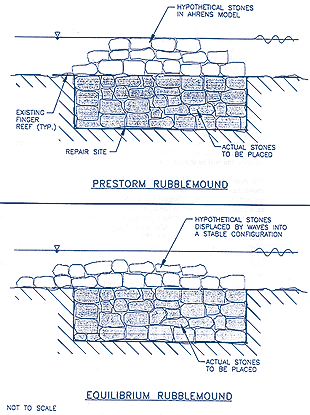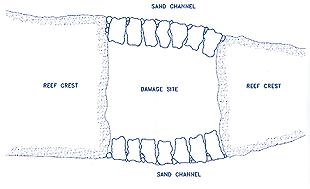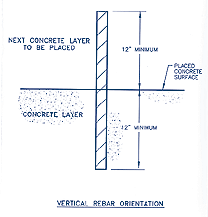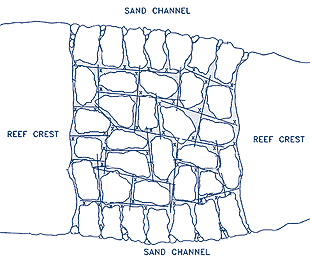|
Introduction
The
grounding of the R/V Columbus Iselin
impacted the reef's surface and crushed the
structural framework below the vessel's hull,
resulting in exposure of vulnerable sub-surface
reef structure. This reef structure is composed of
lightly, naturally cemented coral fragments. Eight
areas of damage were identified, including four
severely impacted spurs. The grounding impacted
approximately 3,749 square feet of reef area with
the loss of approximately 7,503 cubic feet of reef
material (Coastal Planning & Engineering,
Multibeam Survey Results, July 1997). Additionally,
this damage made the reef structure susceptible to
further reoccurring damage from storm events. Storm
waves from Hurricane Georges scoured out reef
material at the four severely damaged sites, almost
doubling the material (volume) losses from the
initial damage incident. Survey results indicate
that the volume of lost reef material increased
from 7,503 to 13,827 cubic feet following the
hurricane. Until the reef spurs are repaired and
stabilized, the damaged areas are at risk of
further storm damage. This project is intended to
restore and stabilize the structure of the damaged
reef spurs.
Design
Concept
The
proposed repair plan involves the use of limestone
boulders, placed in the four damage depressions in
the reef and stabilized with a tremie pour of
specialized marine concrete around the boulders.
Each structure will be constructed by first placing
a layer of boulders into the bottom of the damage
hole. Concrete will be poured around this layer,
filling interstitial spaces and attaching the layer
to the sides and bottoms of the cavity to the
greatest extent possible. The concrete fill will
terminate just above the boulders' widest sections
to stabilize the boulder layer and provide for
secure placement of the next layer.
|

|
|
Side
view of boulder layers placed in the
damage depression in the reef. Click on
the image to view a larger, more detailed
version.
|
Next, corrosion resistant fiberglass rebar will be
placed in the concrete for improved attachment to
the next concrete/boulder layer. The concrete
surface will also be rough to allow for improved
adhesion to the upper layer. Layers will be
constructed above one another in a similar manner
until the reef spur is restored. When restoration
is completed, the surface will consist mostly of
limestone boulders, with concrete interstitial fill
below the boulders' crests. Some of the repair
units have sides that will be exposed to deeper
areas. Along these sides, the structure will be
formed to replicate, as closely as possible, the
undisturbed reef slopes. The limestone boulders
used in repair will weigh from three to five tons
and generally feature diameters of about four feet.
Once completed, each reef repair unit will be a
solid structure.
(top)
Stability
Analysis
Once
the reef repair structures are constructed, their
stability in storms is of utmost importance. Wave
climate and stability analyses were conducted to
ensure restoration structures will be able to
sustain a 50-year storm as well as other storms.
The stability analysis was based on predictions for
reef breakwaters and rubble mound structures fully
exposed to storm waves, without the sheltering of
adjacent reefs and at a shallower depth than the
proposed reef repair structures. This provided a
conservative approach.
The
stability analysis assumes the most critical site
conditions, a water depth of six feet National
Geodetic Vertical Datum over the adjacent reef
crest, and thus over the crest of the design fill
structure. Assumptions also include a 50-year surge
of 8.8 feet and depth-limited waves over the
structure. The 50-year storm surge elevation
estimate was based on 50-year return period
stillwater elevations available for several onshore
sites within seven miles of Looe Key reef (storm
surge information was not available for the Looe
Key site). The limestone rock density is assumed to
be 140 pounds per cubic foot.
|

|
|
One
stability analysis was based on
predictions for reef breakwaters and
free-standing rubble mounds fully exposed
to storm waves. It assumes that if less
than 100% of the rubble mound is
destabilized, then the structure below is
stable.
|
Three analyses were used to test the stability of
the structures in storm waves. Two are based on
work conducted at the Corps of Engineers Coastal
Engineering Research Center and one on the Shore
Protection Manual. The first of these analyses
represents, as a relatively conservative approach,
a prediction of the stability of a free-standing
rubble mound, without the benefit of the concrete.
With this approach, the post-storm shapes of rubble
mound structures following ultimate wave damage are
evaluated to determine structure stability. If at
least the lower layer of the rubble mound
structures are found to be stable, then the
structure below the hypothetical rubble mound
breakwater (the reef repair) should be stable. The
analysis is conservative considering the boulders
used in reef repair will be: placed in a reef
depression; transformed into a single unit by the
tremie pour concrete; and at a lower elevation than
the breakwater boulders. Results indicated that the
bottom layer of mound will be stable and, thus, the
repair will be stable.
The
second analysis was conducted to investigate the
structural stability of the design, including the
benefit of using concrete to create a single, solid
structure at each site. The "fill" is defined as
the combined boulder/concrete unit that will be
created in each of the reef cavities. The
interpretation of the results accounts for the fact
that the effective sizing of the fill is increased
beyond that of the individual boulders due to the
adherence of the interstitial concrete. The
adherence between the concrete and boulders is
expected to be adequate to withstand the storm
conditions, due largely to the irregular shapes and
rough surfaces of limestone quarry boulders. The
analysis indicated that to ensure conservatively
adequate stability, an effective boulder size of 19
tons would be required. This would be represented
by a boulder approximately 7 feet in diameter. In
comparison, the smallest repair unit will be over
15 feet wide at the narrowest point, and several
feet in average thickness. Thus, the stability of
the structure fill material is predicted to be
adequate.
The
final analysis was similar to the second analysis.
It is the most sensitive to storm wave height and
was used to verify stability in severe storms. This
analysis is based on the "Stability of Rubble
Structures" relationship presented in the Shore
Protection Manual. It involved applying the most
severe predicted storm conditions at the Looe Key
project area to determine the effective boulder
sizing required to result in a stable boulder at
Looe Key. Results indicated that boulders placed in
such an environment would require sizing of 27 tons
(about eight feet in diameter). The effective
boulder sizing of the repair units will exceed this
size (as discussed above), verifying adequate
stability of the Looe Key reef repair.
Additionally, based on volumes determined from a
bathymetric survey, the weight of boulders and
concrete used to fill the damaged spurs will
greatly exceed 27 tons.
Each
analysis approach was based on conservative
applications of the potential wave climate.
Although their particular results vary, all
indicate the adequate stability of the proposed
reef repair design.
(top)
Construction
Methods
Limestone
boulders will be obtained from a quarry, most
likely in the Key Largo area. The boulders will be
washed at the quarry site and transported by truck
to the contractor's barge. The barge will transport
the boulders to the site for placement within the
reef repair site.
At
the project site, the barge will be positioned with
five previously established mooring points. If the
existing mooring points are insufficient for
securing the barge, the contractor, in cooperation
with sanctuary personnel, may establish additional
mooring points.
|

|
|
Top
view of perimeter boulders sealed with
grout to create a "form" for the placement
of tremie pour concrete within the cavity.
Click on the image to view a larger, more
detailed version.
|
Boulders will be lifted into place by a crane
located on the barge. Initially, boulders and
smaller chinking rocks will be placed along the
perimeter of the damage site that coincides with
the edge of the reef spur, and thus with deeper
adjacent bathymetry. The spaces between and around
the boulders on the perimeter will be grouted with
concrete to form an impervious seal. The purpose of
these sealed perimeter boulders is to create a
"form" for the eventual placement of tremie pour
concrete within the cavity. After the perimeter
boulders have been sealed, interior three to five
ton boulders will be placed within the damage site
cavity. The boulders will be placed closely
together, but sufficient space will be left
|

|
|
Fiberglass
rebar will be inserted into the concrete
to assist in attachment of
concrete/boulder layers. Click on the
image to view a larger, more detailed
version.
|
between the boulders for concrete placement. After
the first layer of boulders has been placed in the
cavity, tremie pour concrete will be pumped between
the boulders. The upper one-third of the boulders
will not be covered with cement during the first
pour so that this first layer of boulders will
provide attachment to the second layer of boulders
and concrete that follow. Additionally, rebar will
be inserted into the concrete layers of the repair.
This procedure will be repeated for the additional
layers of boulders and will continue until the
surface layer of boulders is placed. It is
anticipated that no more than three layers of
boulders will be required at any location. The top
layer of boulders will be placed to emulate the
relief of the natural reef.
The
concrete formula to be used in the tremie pour is
the same that was used at the Elpis-Maitland
restoration in the Upper Keys in 1995. The concrete
will be mixed aboard the contractor's barge and
pumped through hoses to the voids between the
boulders. The contractor is required to contain all
materials on board the barge, to guard against
accidental releases of water or concrete into the
water column.
Following
restoration of the physical reef structure,
on-going monitoring for structural integrity and
biological recovery will be conducted. Biological
restoration of the Columbus Iselin site is
planned for the future.
|

|
|
Top
view of boulders, rebar and concrete
placed in damage depression. Click on the
image to view a larger, more detailed
version.
|
(top)
|

